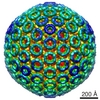+Search query
-Structure paper
| Title | Electron cryo-microscopy and single-particle averaging of Rift Valley fever virus: evidence for GN-GC glycoprotein heterodimers. |
|---|---|
| Journal, issue, pages | J Virol, Vol. 83, Issue 8, Page 3762-3769, Year 2009 |
| Publish date | Feb 4, 2009 |
 Authors Authors | Juha T Huiskonen / Anna K Overby / Friedemann Weber / Kay Grünewald /  |
| PubMed Abstract | Rift Valley fever virus (RVFV) is a member of the genus Phlebovirus within the family Bunyaviridae. It is a mosquito-borne zoonotic agent that can cause hemorrhagic fever in humans. The enveloped ...Rift Valley fever virus (RVFV) is a member of the genus Phlebovirus within the family Bunyaviridae. It is a mosquito-borne zoonotic agent that can cause hemorrhagic fever in humans. The enveloped RVFV virions are known to be covered by capsomers of the glycoproteins G(N) and G(C), organized on a T=12 icosahedral lattice. However, the structural units forming the RVFV capsomers have not been determined. Conflicting biochemical results for another phlebovirus (Uukuniemi virus) have indicated the existence of either G(N) and G(C) homodimers or G(N)-G(C) heterodimers in virions. Here, we have studied the structure of RVFV using electron cryo-microscopy combined with three-dimensional reconstruction and single-particle averaging. The reconstruction at 2.2-nm resolution revealed the organization of the glycoprotein shell, the lipid bilayer, and a layer of ribonucleoprotein (RNP). Five- and six-coordinated capsomers are formed by the same basic structural unit. Molecular-mass measurements suggest a G(N)-G(C) heterodimer as the most likely candidate for this structural unit. Both leaflets of the lipid bilayer were discernible, and the glycoprotein transmembrane densities were seen to modulate the curvature of the lipid bilayer. RNP densities were situated directly underneath the transmembrane densities, suggesting an interaction between the glycoprotein cytoplasmic tails and the RNPs. The success of the single-particle averaging approach taken in this study suggests that it is applicable in the study of other phleboviruses, as well, enabling higher-resolution description of these medically important pathogens. |
 External links External links |  J Virol / J Virol /  PubMed:19193794 / PubMed:19193794 /  PubMed Central PubMed Central |
| Methods | EM (single particle) |
| Resolution | 20.0 - 30.0 Å |
| Structure data |  EMDB-1549:  EMDB-1550: |
 Movie
Movie Controller
Controller Structure viewers
Structure viewers About Yorodumi Papers
About Yorodumi Papers



